A key focus of my blog is Technology. Not everyone is familiar with cladding though it is a key aspect of constructing and optimizing buildings and building usage. The following contributed post is entitled, An Introduction To Cladding.
* * *

https://www.pexels.com/photo/tiled-black-wall-of-modern-building-against-white-sky-3449680
Cladding does not form an integral part of the building, but covers it, shielding it from the elements and from heat loss. It also provides a range of other benefits, such as protecting the fabric of the building from damage, offering additional security and aesthetic appeal.
What Is Cladding?
It is first worth explaining the wider term that you’ll often see in the same context – the ‘building envelope’. Simply put, the building envelope encompasses all the elements that go to make up the physical separator between the internals of any building and the exterior. That might include the floor and roof, the walls and the doors, along with any roof lights or roof windows that might be fitted to the property in question. The building envelope is what helps to preserve a controlled interior environment that protects the building, its occupants and any activity that takes place within from what’s outside. That might primarily be the weather in the majority of cases, but could also include noise pollution. It is additionally expected to provide thermal insulation and control heat loss from the building, and even protect against fire, whether from spreading from in the building or from entering the building if the fire is outside its walls.
Cladding can be one important element of the building envelope. Whether incorporated into the original design of the building or added later as part of a refurbishment, rain shield composite panels involve applying an additional layer to the outside of the building. It’s not part of the structure in the same way as bricks and mortar or timber may be, but it’s a skin which helps to offer a further degree of weather resistance and thermal insulation. Cladding can also add to the aesthetic appearance of the building.
The Benefits Of Cladding
So having given a broad outline, what advantages does cladding offer to a building? Whether you are a business owner or a homeowner, you’ll know that there’s pressure on us all to reduce our energy consumption for environmental reasons. With energy prices rising all the time, we understand that’s to our benefit from a cost point of view too. The Carbon Trust’s research has shown that up to 60% of the energy used to heat a typical office is lost through the fabric of the building. Around 22% alone escapes through the roof and 9% through the walls. Cladding provides a degree of insulation that can prevent those losses, and therefore, reduce a business’ spend on the costs of heating its premises.
Wall cladding also plays an important role in preserving the fabric of the building. While it doesn’t strictly add to the structural integrity and therefore, the stability of the construction, it can prolong its lifespan in a number of ways. From directing rainwater away, so it does not infiltrate and damage the building’s structure to forming protection against the spread of fire, cladding can ensure your home or business premises need less maintenance on an ongoing basis and will survive longer than without it. By adding a level of soundproofing, it also protects privacy internally and reduces external noise pollution. And finally, it can be used to create an external façade that is more attractive or blends in better with its surroundings than that of the structure itself.
